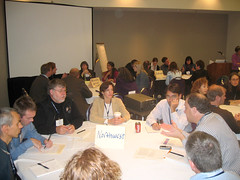 Image by bryankennedy via Flickr
Image by bryankennedy via Flickr
So what conferences out there are worth your time and your money? I am going to offer my top ten of the leading edge technology conferences regionally and nationally. (One regional event and 10 national events.) If you have attended other events or know of other events out there that offer cutting edge innovation techniques, educational technology applications and integration at high levels - please feel free to share.
KySTE - KySTE's (Kentucky Society for Technology in Education) Spring Conference (March 10-12, 2010) is quickly becoming the technology conference in KY and the surrounding states. Growing at a rapid rate and keeping the emphasis on education technology (integration, implementation and innovation), this event has the potential to become something special. This year's event will highlight nationally renowned speakers, KY leaders and sessions centered around leadership, technical, planning and resources. If you live in/around KY (especially the Louisville, KY area), I highly encourage you to attend this year's KySTE event.
NECC - I have attended 3 NECC (National Educating Computing Conference) conferences over the past 6 years and each one offers unique and different options and sessions. The events I have attended always offer quality sessions, national speakers/keynotes/presenters and a top notch vendor hall. I have used NECC events to see what other districts are doing across the country, as well as take a look at vendors that don't always make it into KY. If you have never attended an NECC event, try out this year's event in Denver, as I believe as an educational technology leader it is worth the trip.
FETC - Florida's premier technology conference is quickly becoming one of the nations top educational technology events. I had the privilege of attending a portion of last years FETC event in Orlando as a part of some BLE CIO panel sessions and was amazed at the size of the event. FETC is able to attract some of the premier educational technology leaders while offering cutting edge sessions centered around technology in the classroom. I believe this event is worth at least 1-2 trips for any ed tech leader looking to see what a large scale state conference looks like and how leaders across the state of Florida communicate and collaborate.
EdNet - While I haven't actually attended any EdNet (Educational Networking Conference) sessions, I heard many positives about the event while in Chicago last year. EdNet's purpose is gather for networking opportunities, discuss emerging technologies and see what is ahead for the market. From my understanding, the event is designed for businesses to grow and stay involved in Ed Tech trends, etc. but it also provides ed tech leaders the opportunity to connect and network with those said vendors. Great possibilities for those able to attend.
CoSN - The Consortium for School Networking is probably the premier organization for educational technology leadership in the country. CoSN provides exciting keynotes, great networking opportunities, dynamic presentations and new emerging technologies. I have never attended CoSN's event either, but am already making plans for this years event in DC. If you are interested in Educational Technology Leadership and networking with some of the best across the country, make plans for this event.
CES - When you hear of CES or Consumer Electronics Association's event in Las Vegas, only thing comes to mind: New Technologies. CES has made a history of being THE premier event for new and emerging technologies across the world. Whether your interest is emerging tech, audio/video, wireless or even gaming - CES will be showcasing the latest and greatest from top vendors. If you have never attended a CES (aside from it being in Vegas), make plans to attend one. You will come away with new ideas and products that could be of benefit to your district.
TCEA - The Texas Computer Education Association makes a claim about their organization and conference, no one else can: It is the largest state organization dedicated to the use of technology in education. Much like Florida's FETC, TCEA has emerged as one of the "go to" state technology events. Having a large bass of districts and vendors (home of Dell, AT&T, HP, Nortel/Avia and of course Texas Instruments) TCEA is able to pull large groups of ed tech leaders and followers into a single setting for a powerful event. This year's event is the 30th annual TCEA and promises to be one of their best.
BLC Conference - The Building Learning Communities / November Learning conference has emerged as one of the most innovative and fastest growing educational technology events in the country. Featuring renowned technologist Alan November and his team, the BLC conference is designed to create a global community of dynamic educators. The keynote sessions, pre-conference workshops and main sessions all are designed to challenge your thinking with innovative ideas about empowered teaching and learning. I believe this conference is a must for leading educators and one districts must seriously consider as an event to send an entire team to attend.
NSBA T+L - The National School Board Association's T+L conference is one of the nation's most recognized education technology conferences. The conference centers around technology but also provides vision, leadership and other areas of education for all members of a school district. I had the opportunity to attend a few sessions at the 2008 T+L in Seattle, WA along with visiting the exhibit hall and liked what I saw. My hope is that when the next T+L event is within driving distance of my district, we can take a team to experience what it has to offer.
Northwest Council for Computer Education - This is a new one to me. I actually came across it today in looking for other educational technology conferences across the country. NCCE is a non-profit organization that supports effective use of technology in education to the Pacific Northwest. Their conference is designed to showcase the latest programs, projects, lessons, ideas and concepts not only in the NW but the country. From what I have read it is one of the premier conferences in the country.
TechEd 2010 - Another new one to me. I came across this event while searching for premier events. Tech Ed appears to be one of the leading conferences in California. This year's event is in Pasadena in April, so for those on the west coast, if you haven't already, check out Tech Ed.
Please feel free to offer thoughts on the conferences above and add any information about conferences/events/workshops that you have either heard of or attended.
Have a safe and Happy New Year!
JDS | CIO
![Reblog this post [with Zemanta]](http://img.zemanta.com/reblog_e.png?x-id=6235de22-5996-40f2-8b58-36dbf3db3c28)
![Reblog this post [with Zemanta]](http://img.zemanta.com/reblog_e.png?x-id=e1af61de-f999-4991-aea7-38c88e29cfa0)

![Reblog this post [with Zemanta]](http://img.zemanta.com/reblog_e.png?x-id=d9ae779f-1271-4aca-aa02-288cc92a48b1)
![Reblog this post [with Zemanta]](http://img.zemanta.com/reblog_e.png?x-id=e2b71fc3-b361-4546-82a4-19e891b57818)
![Reblog this post [with Zemanta]](http://img.zemanta.com/reblog_e.png?x-id=910ada66-f9bc-4666-82fb-ef3d847adf02)

![Reblog this post [with Zemanta]](http://img.zemanta.com/reblog_e.png?x-id=a255c026-1963-442b-9e08-494cdc3b11ad)
![Reblog this post [with Zemanta]](http://img.zemanta.com/reblog_e.png?x-id=cc298800-97c6-47eb-87fd-281fd41534f9)

![Reblog this post [with Zemanta]](http://img.zemanta.com/reblog_e.png?x-id=61b504f3-2ff6-40c0-9b67-c039ecd14c25)

![Reblog this post [with Zemanta]](http://img.zemanta.com/reblog_e.png?x-id=bd8e57db-3968-4a6b-9197-69b7be297b69)

![Reblog this post [with Zemanta]](http://img.zemanta.com/reblog_e.png?x-id=e23b8010-ab4a-4d4d-83d7-f86107c6280f)
![Reblog this post [with Zemanta]](http://img.zemanta.com/reblog_e.png?x-id=9e0a7a25-98b3-4762-b93c-0ad6b0cfdf53)

![Reblog this post [with Zemanta]](http://img.zemanta.com/reblog_e.png?x-id=ad7e3711-b856-4cd6-8cc8-7d378ccfa6a6)
![Reblog this post [with Zemanta]](http://img.zemanta.com/reblog_e.png?x-id=60ad9a65-d13a-4583-b286-b43f97f30b48)

![Reblog this post [with Zemanta]](http://img.zemanta.com/reblog_e.png?x-id=97b578ec-192b-447d-8358-0233557b5bd6)

![Reblog this post [with Zemanta]](http://img.zemanta.com/reblog_e.png?x-id=8aeb981a-64e7-403c-a6b3-f94e008413e3)

![Reblog this post [with Zemanta]](http://img.zemanta.com/reblog_e.png?x-id=3b2adcd9-e317-44d4-8eba-1821b90a1be8)
![Reblog this post [with Zemanta]](http://img.zemanta.com/reblog_e.png?x-id=0794051f-19b8-468e-9614-d56e1aeea981)
![Reblog this post [with Zemanta]](http://img.zemanta.com/reblog_e.png?x-id=4a6563c2-2b88-4b1c-a9a9-1bf1bca17c0a)
![Reblog this post [with Zemanta]](http://img.zemanta.com/reblog_e.png?x-id=1ed64780-c006-4632-8a63-2fd8f3e732df)

![Reblog this post [with Zemanta]](http://img.zemanta.com/reblog_e.png?x-id=a63ebef2-ef5e-4d02-96d5-dc28d7e07e95)
![Reblog this post [with Zemanta]](http://img.zemanta.com/reblog_e.png?x-id=8273db5e-86c1-490d-91a5-0f1c07f9b1ea)

![Reblog this post [with Zemanta]](http://img.zemanta.com/reblog_e.png?x-id=a65063aa-abd8-4469-a514-a3c466968655)

![Reblog this post [with Zemanta]](http://img.zemanta.com/reblog_e.png?x-id=5d3d03b6-7269-47ce-99f8-5ddbdf20c66f)

![Reblog this post [with Zemanta]](http://img.zemanta.com/reblog_e.png?x-id=c9e0240c-b748-45c3-a857-af5d7d26eee5)


![Reblog this post [with Zemanta]](http://img.zemanta.com/reblog_e.png?x-id=bf9ec1a6-daf2-412b-b80b-8e6ef065a7af)
![Reblog this post [with Zemanta]](http://img.zemanta.com/reblog_e.png?x-id=6f38f2a7-da3b-4a7d-9a82-b6b38a945752)


